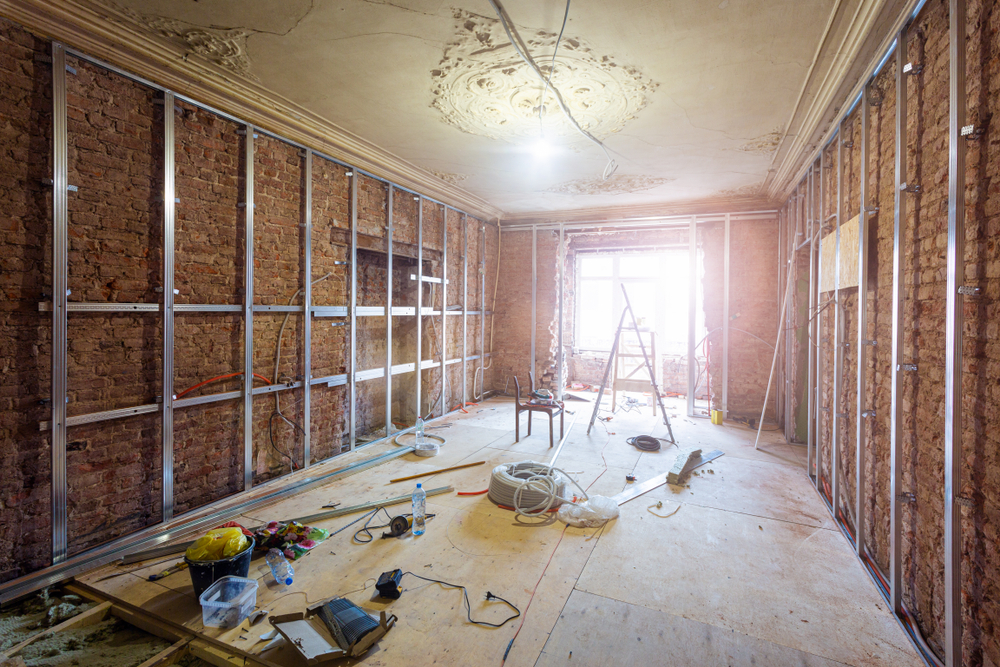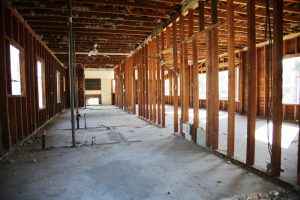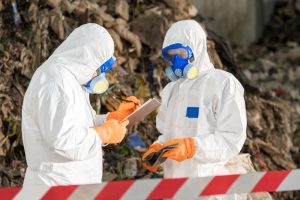Renovating a charming old building holds a certain allure, but hidden dangers can lurk beneath the antique fixtures and vintage details. Renovating an older structure has financial benefits in that you don’t need to construct an entirely new building from scratch, especially if a structure has the perfect location for your business or organization.
In addition to the beauty of bygone days, these historical gems may harbor a legacy of health hazards, from microscopic asbestos fibers to lingering water damage that fosters mold growth.
Environmental Demolition Group delves into the potential health risks associated with old buildings, exploring common culprits like asbestos, lead, and hazardous materials in general that must be cleaned out before renovation can take place.
Abatement and Remediation Services in Older Buildings
Renovations and restoration projects in these structures can inadvertently expose occupants to a range of dangers like asbestos, lead, mold, and PCBs (polychlorinated biphenyls). This is where abatement and remediation services become vital to safeguarding human health and creating a safer environment for everyone in the building.
Understanding Abatement & Remediation
While both terms deal with hazardous materials, abatement and remediation serve distinct purposes:
Abatement
Abatement focuses on stopping the source of the hazard and minimizing its immediate threat. Imagine it like extinguishing a fire. The flames are stopped, but the underlying problem (faulty wiring) might need further attention. In an older building, abatement could involve encapsulating asbestos-containing materials to prevent fiber release or removing lead paint chips so no one inhales any lead paint dust.
Remediation
Remediation involves completely removing the hazard and restoring the affected area to a safe and healthy condition. Think of it like rebuilding after a fire. The burned debris is removed, the smoke damage is cleaned, and the structure is repaired to be habitable again. Remediation for mold growth could involve removing the mold, thoroughly disinfecting the area, and addressing the source of moisture to prevent future growth.
The Need for Hazardous Material Removal in Older Buildings
Renovation projects in older buildings often uncover hidden dangers from their past construction, especially if they were built before the 1980s. Here’s why professional abatement and remediation services are necessary for these structures:
Demolition before a renovation can disturb materials like asbestos or lead paint, releasing harmful particles. Mold growth might be hidden behind walls or under floorboards. Professionals use specialized tools and expertise to identify and locate these hazards before they pose a threat.
Removing hazardous materials requires specific protocols to minimize exposure risks. Professionals are trained in safe removal techniques, utilizing personal protective equipment (PPE) and containment measures to protect the work environment and surrounding areas.
Hazardous materials like asbestos and lead require specific disposal procedures to prevent environmental contamination. Trained professionals handle these materials’ safe transport and disposal according to strict regulations.
Regulations governing the handling and removal of hazardous materials vary by location. Professionals understand these regulations and ensure projects comply with all legal requirements on the federal, state, and local levels.
Common Hazards in Older Buildings
Several types of hazardous materials can be present in older buildings, each requiring specialized abatement or remediation approaches.
Asbestos
This fire-resistant material, once widely used in building materials, can cause serious health problems when inhaled. Abatement involves removing or encapsulating asbestos to prevent fiber release.
Lead
Often found in paint and plumbing components of older structures, lead can be particularly harmful to children. Abatement methods involve removing lead-based paint through specialized techniques or encapsulating it.
Mold
Mold growth thrives in damp environments and can cause respiratory problems and allergic reactions. Remediation involves removing the mold, thoroughly disinfecting the affected area, and addressing the source of moisture to prevent future growth.
PCBs (Polychlorinated Biphenyls)
These industrial chemicals, once used in electrical equipment and caulk, can cause various health problems. Abatement involves removing PCB-containing materials and disposing of them according to strict regulations.
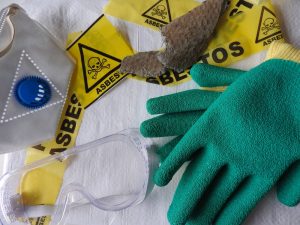
Asbestos in Older Buildings
Once a widely used material prized for its heat and fire resistance, asbestos is a severe health hazard. Understanding its presence and potential risks is crucial for anyone living in or renovating an older building.
What Is Asbestos?
Asbestos refers to a group of naturally occurring fibrous minerals. These microscopic fibers are strong, heat-resistant, and fire-retardant. Because of these properties, asbestos was incorporated into a wide range of building materials from the early 1900s until the late 1970s.
Why Was Asbestos Used?
Asbestos’s heat and fire resistance made it a versatile and seemingly perfect building material. It was used in:
- Insulation. Asbestos was a common component in attic insulation, wall insulation, and pipe insulation.
- Fireproofing. Asbestos was used in fireproofing materials sprayed on ceilings, beams, fire doors, and caulk.
- Building materials. Asbestos was incorporated into floor tiles, ceiling tiles, roofing shingles, siding shingles, and certain drywall joint compounds.
- Other products. Asbestos was also found in various other building products, including plaster, textured paint, vinyl floor tiles, and some HVAC ductwork.
Where Is Asbestos Commonly Found?
While the use of asbestos in new construction has been primarily banned, it remains a concern in older buildings constructed or renovated before the late 1970s. Here are some of the most common locations where asbestos might be found:
- Attics and Basements. These areas often contain asbestos insulation around pipes and boilers.
- Walls and Ceilings. Textured paint (popcorn ceilings) and some types of plaster can contain asbestos.
- Floors. Vinyl floor tiles and adhesives used to lay out flooring may contain asbestos.
- Bathrooms. Asbestos can be present in bathroom floor tiles, vinyl flooring, and bathroom caulking.
- HVAC Systems. Some types of ductwork and insulation around boilers and furnaces may contain asbestos.
Dangers of Asbestos Exposure
The health risks associated with asbestos exposure are significant and can take decades to develop. When disturbed, asbestos fibers become airborne and can be easily inhaled. These tiny fibers can lodge themselves deep within the lungs, causing long-term damage and severe health problems.
Symptoms of Asbestos Exposure
Asbestos-related diseases often don’t present symptoms until 10 to 40 years after initial exposure. Common symptoms include:
- Shortness of breath. This is often the earliest symptom and can gradually worsen over time.
- Wheezing. A persistent wheezing sound when breathing may be a sign of lung damage.
- Chest tightness. A feeling of tightness or discomfort in the chest can be an indicator of lung scarring.
- Dry cough. A chronic cough that doesn’t improve can be a symptom of asbestos exposure.
- Fatigue. General fatigue and tiredness can be associated with lung issues caused by asbestos.
Serious Health Conditions
Inhaling asbestos fibers can lead to several severe health conditions, such as:
- Asbestosis. This chronic lung disease causes scar tissue to form in the lungs, making it difficult to breathe.
- Lung Cancer. Asbestos exposure is a significant risk factor for lung cancer.
- Mesothelioma. This is a rare and aggressive form of cancer that affects the lining of the lungs, chest, or abdomen.
Yes, there are potential dangers from hazardous materials lurking beneath the surface of older buildings. But with the right selective demolition company like Environmental Demolition Group, your project can move forward to completion.
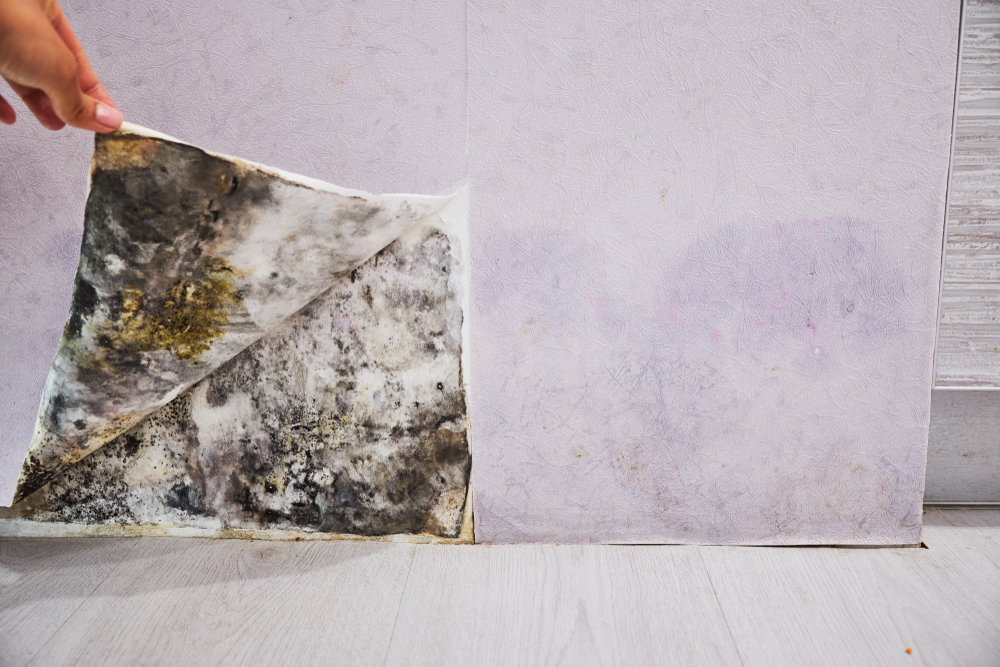
Mold in Older Buildings
Mold spores are ever-present in the environment, but when they find a damp and hospitable space within a building, they can quickly colonize, posing a threat to both the structure and the health of its occupants. Getting rid of (or remediating) mold is the only way to ensure the building is safe for its occupants.
Health Dangers of Mold
Mold exposure can have a range of adverse health effects, especially for those with allergies, asthma, or weakened immune systems. It is also particularly dangerous for young children because their respiratory systems are still being developed. Common symptoms may include:
- Respiratory problems. Mold exposure can irritate the respiratory tract, leading to coughing, wheezing, shortness of breath, and congestion.
- Allergic reactions. Mold spores can trigger allergic reactions, causing sneezing, runny nose, itchy eyes, and skin irritation.
- Other health effects. In some cases, exposure to certain types of mold may be linked to headaches, fatigue, dizziness, and even neurological problems.
It is also important to note that mold may not be causing any active or noticeable symptoms, but that does not mean it will not cause any difficulties later.
How Mold Damages Buildings
Beyond health concerns, mold can also cause significant damage to a building’s structure. As it grows, mold feeds on organic materials such as wood, drywall, and insulation. This means It feeds on the building itself, which can pose a huge threat to anyone inside. The damage caused by mold can lead to:
- Structural weakening. Mold can weaken building materials, potentially compromising the integrity of walls, floors, and ceilings.
- Increased maintenance costs. The longer mold remains untreated, the more extensive the damage becomes, leading to higher repair costs and more expensive remediation methods.
- Decreased property value. The presence of mold can significantly reduce the value of a property. It could even be condemned by local authorities, meaning its value is essentially worthless.
Common Causes of Mold Growth in Older Buildings
Older buildings are particularly susceptible to mold growth due to several factors, many of which may not be seen:
- Leaking roofs and plumbing: Any source of water intrusion, whether from a leaky roof, faulty plumbing, or condensation on pipes, can create a damp environment perfect for mold growth.
- Poor ventilation: Inadequate ventilation allows moisture to build up within the building, creating a breeding ground for mold. This can be a problem in older buildings with limited ventilation systems or those with windows that are often kept closed.
- Lack of insulation: Poor insulation allows for temperature fluctuations and condensation to occur on walls and ceilings, providing moisture for mold growth.
Mold Remediation
If you suspect mold growth in your older building or renovation project, here’s what you should do:
1. Identify the source of moisture.
This depends on if the building is still in use or if it has been vacant for a while. For a building still in use, look for leaky pipes, condensation, or signs of water damage.
2. Contain the mold.
To prevent further spread, isolate the affected area by sealing it off with plastic sheeting.
3. Assess the extent of the damage.
It’s essential to determine the severity of the mold growth. A professional selective demolition company like Environmental Demolition Group is specifically trained to handle this type of hazardous material in your building.
4. Remediate the mold.
Professional mold remediation companies have the expertise and equipment necessary to safely and effectively remove mold and prevent its recurrence. They will use specialized techniques such as air scrubbing and HEPA filtration to remove mold spores and ensure a healthy living environment.
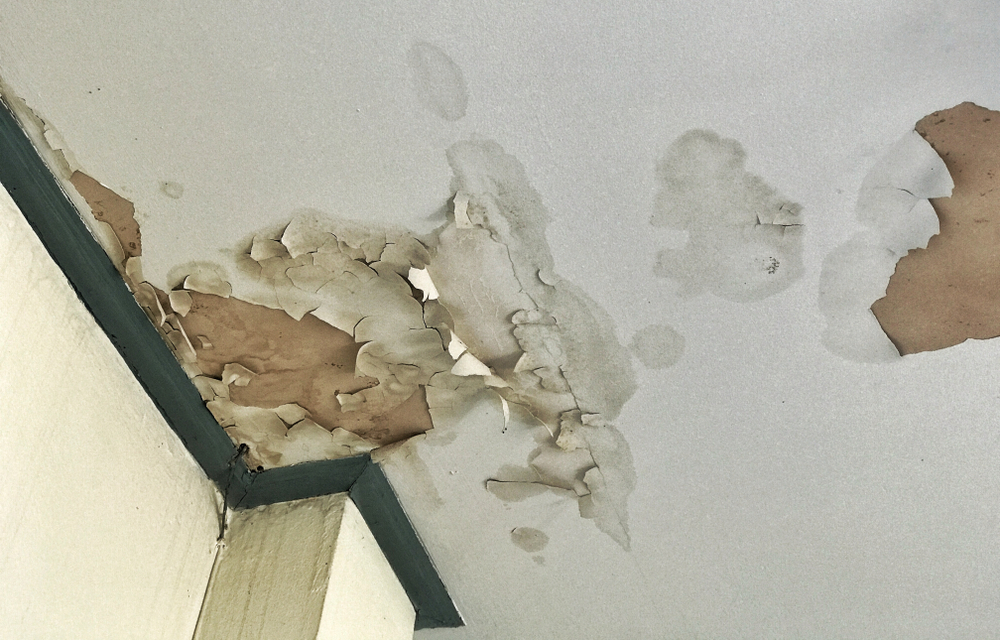
Water Damage in Older Buildings
Over time, leaks, breaches, and faulty systems can introduce moisture that wreaks havoc on both the building’s structure and poses risks to the building’s inhabitants. Water damage can also lead to mold growth.
How Water Damage Occurs in Older Buildings and Structures
Several factors contribute to water damage in older buildings:
- Deteriorated building envelope. As buildings age, their roofs, siding, and windows can deteriorate, allowing water to seep in during heavy rain, snowmelt, or wind-driven storms.
- Plumbing failures. Older plumbing systems are more susceptible to leaks due to corroded pipes, faulty joints, or worn-out gaskets.
- Drainage issues. Clogged gutters, faulty downspouts, or improper grading around the foundation can cause water to pool around the building and eventually leak inside.
Familiar Places to Find Water Damage
Water damage can manifest in various locations within an older building:
- Attics and basements. These areas are particularly vulnerable as they are often less insulated and exposed to the elements. Common signs include water stains, peeling paint, and mold growth on ceilings or walls.
- Walls and ceilings. Water leaking from roofs, pipes, or exterior walls can cause visible water stains, warping, and bubbling of drywall or plaster.
- Floors. Water damage can manifest as warped floorboards, buckling tiles, or carpeting or hardwood flooring discoloration.
- Bathrooms and kitchens. These areas are prone to leaks around sinks, tubs, showers, and appliances. Look for mold growth, cracked tiles, or soft spots around fixtures.
The Dangers of Not Repairing Water-Damaged Areas
Leaving water damage unaddressed can have a cascade of negative consequences and will have to be addressed during a renovation project.
- Structural damage. Water weakens wood framing, rots floor joists, and can even compromise the foundation, leading to structural instability.
- Mold growth. Water creates a perfect environment for mold spores to thrive. Mold growth can spread quickly, damaging building materials and posing health risks.
- Spread of damage. If left unchecked, water damage can spread from its initial source, causing extensive damage to surrounding areas.
- Health problems. Mold exposure can lead to respiratory problems, allergies, and even neurological issues. Additionally, stagnant water can attract pests like mosquitoes and roaches.
- Decreased property value. The presence of water damage significantly decreases a property’s value.
Removing any water-damaged items is crucial when demolishing the interior of a building ahead of a renovation.
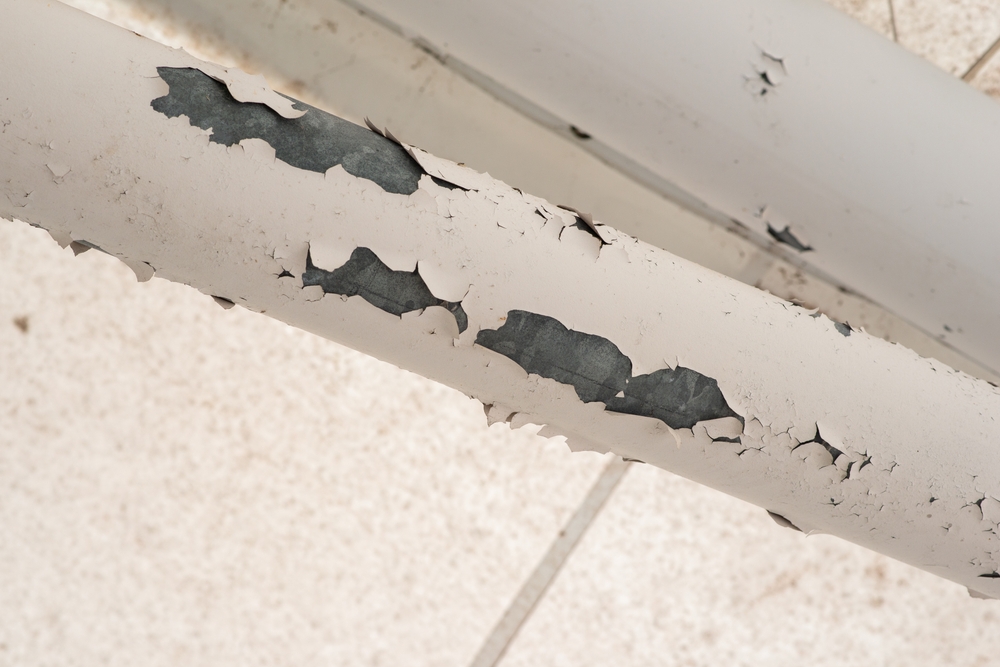
Lead in Older Buildings
Once a widely used material prized for its versatility and durability, lead is now recognized as a severe health hazard. Understanding where lead was used, its risks, and the importance of professional abatement is crucial for anyone living in or renovating an older building.
Where Was Lead Used in Older Buildings?
Lead’s historical popularity in construction stemmed from its desirable properties: durability for long-lasting structures, malleability for shaping and molding, sound dampening for quieter interiors, and even some degree of fire resistance.
These qualities made it a seemingly ideal material for various building components, from paint and plumbing to roofing and electrical systems. Unfortunately, the health hazards of lead exposure, which were not fully understood at the time, were overshadowed by its perceived benefits.
Here are some common lead-containing materials found in older buildings.
- Paint: Lead-based paint was widely used in homes and buildings constructed before 1978. It was applied to walls, ceilings, trim, doors, windows, and even exterior surfaces.
- Plumbing: In older buildings, lead pipes and solder were commonly used for water supply and drainage systems.
- Caulking: Lead-based caulk was used around windows, doors, bathtubs, and sinks to create a watertight seal.
- Glazing: Lead was sometimes used in the putty, holding windowpanes in place.
- Roofing: Some older buildings used lead flashing, a thin sheet used to waterproof roof joints and valleys.
- Other materials: Lead might also be found in miscellaneous building components such as electrical conduits, counterweights in windows, and even some types of hardware.
When Did Builders Stop Using Lead in Buildings?
The dangers of lead poisoning became increasingly recognized throughout the 20th century. In 1978, the U.S. government banned the use of lead-based paint in residential housing and public buildings. However, lead-containing materials may still be present in older structures built before this ban.
Health Hazards of Lead Exposure
Lead exposure, even at low levels, can have a devastating impact on health, particularly for children under the age of six. See the main reasons why lead is so dangerous:
- Developmental problems. Lead can impair brain development, leading to learning disabilities, behavioral issues, and reduced cognitive function.
- Nervous system damage. Lead exposure can damage the nervous system, causing nerve damage, headaches, and even seizures.
- Anemia. Lead exposure can interfere with red blood cell production, leading to anemia and fatigue.
- Kidney damage. Lead can damage the kidneys, affecting their ability to filter waste from the blood.
- High blood pressure. Lead exposure has been linked to an increased risk of high blood pressure in adults.
Where Can Lead Be Hidden?
The insidious nature of lead lies in its ability to lurk unseen in various locations within an older building. These are the most common places where lead can be found:
- Peeling or chipping paint. Lead paint is especially hazardous when it deteriorates, creating dust or chips that children can easily ingest.
- Dust. Lead dust can settle on floors, window sills, furniture, and toys, creating a potential source of exposure. This dust can be generated through paint deterioration, friction from opening and closing doors and windows, or during renovations.
- Soil. Lead paint chips can deteriorate and contaminate the surrounding soil, particularly around the building’s foundation. Children playing in this contaminated soil can be exposed to lead through hand-to-mouth contact.
- Other hidden sources. Lead can be underneath layers of newer paint, in caulking around windows and doors, or even in the dust created by sanding down older surfaces.
Why You Need Professional Lead Abatement
The dangers associated with lead exposure necessitate professional lead abatement in older buildings, particularly when renovating an older structure:
- Expertise and Training. Lead abatement requires specialized equipment, techniques, and safety protocols. Professionals are trained to identify lead-containing materials, contain the work area, and safely remove or encapsulate lead to minimize exposure risks.
- Worker Safety. Abatement workers are equipped with personal protective equipment (PPE) to prevent lead dust inhalation and contamination.
- Proper Disposal. To avoid environmental contamination, lead-containing materials must be disposed of according to strict regulations.
- Testing and Clearance. Following abatement, professionals conduct lead dust clearance testing to ensure the area is safe for reoccupation.
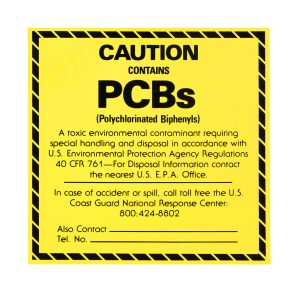
PCBs in Older Buildings
These once widely used industrial chemicals pose significant health risks, lurking unseen in older structures. Understanding PCBs, why they were used, and the importance of professional removal is crucial for anyone living in or renovating an older building.
What Are PCBs?
PCBs are a group of man-made organic chemicals with a range of industrial applications. They are known for:
- Stability. PCBs are resistant to heat, fire, and electrical currents, making them seemingly ideal for various uses. Yet their stability makes them that much more dangerous to public health.
- Insulating properties. PCBs are excellent electrical insulators, leading to their incorporation into electrical components.
- Flame retardancy. PCBs were used as flame retardants in various building materials due to their resistance to combustion.
Why Were PCBs Used in Buildings?
The desirable properties of PCBs led to their extensive use in building materials from the 1930s to the late 1970s. Here’s a look at some typical applications of PCBs:
- Caulking and Sealants. PCBs were incorporated into caulking compounds used around windows, doors, and building joints for waterproofing and sealing purposes.
- Electrical Equipment. PCBs were used as insulating fluids in transformers and capacitors found in electrical systems.
- Paint. Some paints and coatings used in older buildings may have contained PCBs to enhance their flame-retardant properties.
- Fluorescent Lighting Ballasts. The ballasts in older fluorescent light fixtures sometimes contain PCBs.
Where Are PCBs Commonly Found?
While the use of PCBs in new construction has been banned since the late 1970s, potential exposure risks remain in older buildings:
- Caulking around windows, doors, and building joints. Deteriorating caulking can release PCB dust or vapors into the indoor environment, particularly when disturbed during renovations.
- Electrical transformers and capacitors. If not replaced since the ban, these components, especially those located in basements, utility closets, or attics, might contain PCBs.
- Fluorescent light fixtures. Older fluorescent light fixtures with original ballasts may contain PCBs.
- Surrounding surfaces. Over time, PCBs from these materials can migrate and contaminate surrounding building materials like ceiling tiles, wall paint, and dust.
Health Dangers of PCB Exposure
PCBs are persistent organic pollutants, meaning they break down slowly in the environment and can accumulate in the body over time. Exposure to PCBs can lead to various health problems, including:
- Cancer. PCBs are classified as probable human carcinogens by the International Agency for Research on Cancer (IARC). Exposure has been linked to an increased risk of liver cancer, lung cancer, and other cancers.
- Developmental problems. Prenatal and early childhood exposure to PCBs can impair brain development, leading to learning disabilities, behavioral issues, and reduced cognitive function.
- Immune system dysfunction. PCBs can weaken the immune system, making individuals more susceptible to infections and illnesses from these hazardous materials.
- Hormonal disruptions. PCBs can interfere with hormone function, potentially leading to reproductive problems and thyroid issues.
Why You Need Professionals for PCB Removal
The dangers associated with PCB exposure necessitate professional removal or encapsulation by qualified hazardous materials abatement contractors like Environmental Demolition Group:
- Expertise and Training. Due to their hazardous nature, PCBs require specialized handling and disposal procedures. Professionals are trained to identify PCB-containing materials, contain the work area, and safely remove or encapsulate them using appropriate techniques and equipment to minimize exposure risks.
- Testing and Analysis. Testing is crucial to determine the presence and concentration of PCBs in building materials. Professionals utilize specialized testing methods to identify contaminated areas and choose the appropriate course of action.
- Worker Safety. Abatement workers wear proper personal protective equipment (PPE) to prevent PCB exposure during removal or encapsulation procedures.
- Safe Disposal. PCBs must be disposed of according to strict environmental regulations to prevent contamination of air, water, and soil.
- Clearance Testing. Following PCB removal or encapsulation, professionals conduct air and surface testing to ensure the area is safe for reoccupation.

A Guide to Hazardous Waste Removal in Old Buildings
While asbestos, lead, PCBs, and mold are often at the top of our minds during renovations, the list goes far beyond these familiar threats. This guide explores the various types of hazardous waste lurking in older buildings and highlights the importance of professional removal by trained experts.
A Broader Spectrum of Danger
We emphasize that hazardous materials extend well beyond the usual suspects. Here’s a closer look at some of the unexpected hazardous materials that you might find in buildings ahead of your renovation project.
- Mercury: This heavy metal can be found in older thermostats, thermometers, and fluorescent light bulbs. Exposure to mercury can cause neurological damage, respiratory problems, and kidney issues.
- Oil and Petroleum Products: Leaking oil tanks, old machinery, and improper disposal of oil products can contaminate soil and groundwater. Exposure to these materials can lead to skin irritation, respiratory problems, and even cancer.
- Industrial Chemicals: Older buildings might contain remnants of industrial chemicals used in past construction or processes. Depending on their nature, these chemicals can be highly toxic and pose serious health risks.
- Fertilizers and Pesticides: Improper storage or disposal of old fertilizers and pesticides can contaminate soil and water. Exposure can cause a range of health problems, from skin irritation to neurological damage.
- Metal Pilings and Mining Materials: Construction on former industrial sites may encounter metal pilings or mining materials that contain hazardous elements like lead, arsenic, or cadmium. Disturbing these materials without proper precautions can release harmful dust and contaminants.
- Animal Feces and Dead Animals: Large quantities of animal waste, particularly bird droppings and bat guano, can harbor harmful bacteria and fungi. Dead animals trapped within walls or crawl spaces can decompose and release harmful toxins.
Why Professionals Are Essential
While the potential hazards seem daunting, EDG offers a reassuring solution: professional hazardous waste removal. Here’s why relying on trained experts is crucial:
- Expertise and Training. Professionals are trained to identify hazardous materials, assess risks, and implement safe removal protocols. They possess the knowledge and experience to handle these materials with minimal risk of exposure.
- Safety Equipment and Procedures. Proper personal protective equipment (PPE) is essential to protect workers from exposure to hazardous dust, fumes, and contaminants. Professionals utilize appropriate equipment and follow established safety procedures to minimize risks during removal processes.
- Testing and Disposal. Identifying the type of hazardous waste is crucial for safe disposal. Professionals conduct proper testing to determine the best disposal methods according to environmental regulations. This ensures responsible waste management and prevents further contamination.
- Project Management. Hazardous waste removal can be complex, requiring permits and specific disposal procedures. Professionals handle the entire project, from assessment and planning to removal and disposal, ensuring the project runs smoothly and complies with all regulations.
- Peace of Mind. Hiring professionals allows you to focus on the renovation project, knowing that the hazardous materials are handled safely and responsibly. This ensures a healthier environment for workers, future occupants, and the surrounding community.
Renovating or updating an older building can be a rewarding experience, but it’s crucial to be aware of the potential dangers hiding in an older building.
Contact Environmental Demolition Group to request a consultation.

